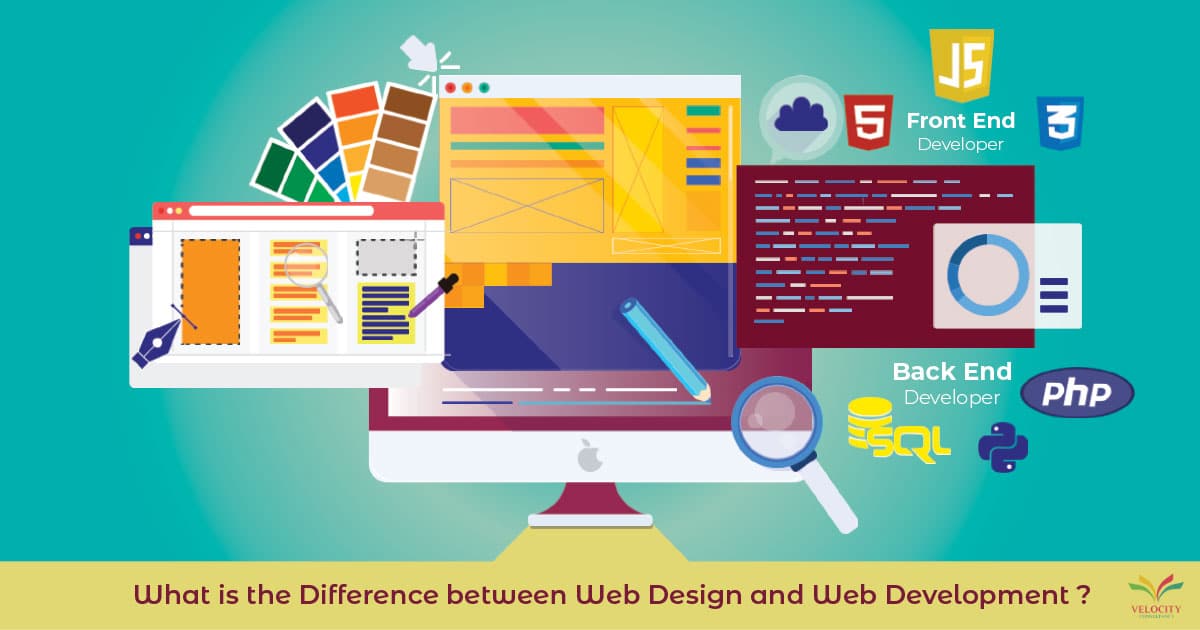Web Design London Ontario Solutions for Small Businesses
Web Design London Ontario Solutions for Small Businesses
Blog Article
How to Successfully Combine Looks and Performance in Web Design
When designing an internet site, you need to strike a balance between aesthetic appeals and performance. It's not almost looking excellent; your design ought to likewise serve a purpose and guide customers efficiently. By concentrating on simplicity and user-friendly navigation, you can create an engaging experience. Yet what elements truly enhance functionality while keeping aesthetic charm? Let's explore the vital concepts that can cause an unified mix of elegance and function.
Recognizing the Significance of Aesthetics and Functionality
When you develop an internet site, recognizing the balance between aesthetics and capability is crucial for creating an effective customer experience. An aesthetically enticing website grabs interest, yet it's the functionality that maintains users engaged. Site visitors will swiftly shed rate of interest and leave.Consider your target audience and what draws them in if your website looks great however is challenging to navigate. You intend to develop a layout that mirrors your brand while making certain convenience of usage. Streamlined layouts, instinctive navigation, and clear calls to activity can enhance both looks and functionality.

Concepts of Reliable Website Design
To produce an efficient internet style, you need to follow numerous key concepts that improve both customer experience and aesthetic charm. Focus on simplicity; a clean format helps individuals browse conveniently. Use a regular color pattern and typography to maintain comprehensibility throughout your website. This promotes knowledge and trust.Next, assure your style is responsive. Users gain access to sites on numerous tools, so your design must adjust perfectly. Focus on aesthetic pecking order; highlight essential components with shade, size, or positioning to guide individuals' focus.Finally, include adequate white space. It stops clutter and makes content much more absorbable. Keep in mind, effective internet style equilibriums appearances and functionality, so every layout selection ought to offer an objective. By adhering to these principles, you'll create a site that's not only visually enticing but also straightforward, eventually keeping visitors engaged and urging them to return.
Focusing On Customer Experience
When prioritizing customer experience, you'll wish to begin by recognizing what your customers genuinely require. Simplifying navigation layout can make a huge distinction in exactly how easily they locate what they're searching for. Likewise, improving aesthetic hierarchy aids lead their interest to one of the most essential elements on your website.
Recognizing Individual Needs
Understanding individual needs is necessary for developing an engaging web experience that maintains site visitors coming back. To achieve this, you need to recognize the objectives and choices of your target audience. Beginning by carrying out user study, like studies or interviews, to collect insights on what individuals value most. When interacting with similar websites, pay focus to their discomfort factors and difficulties. This info allows you to customize your style, guaranteeing functionality lines up with individual assumptions. Additionally, think about developing customer personas that stand for different segments of your audience, assisting you envision their demands throughout the design procedure. When you prioritize comprehending customer needs, you produce a site that not just looks terrific but additionally delivers a smooth, pleasurable experience that fosters commitment.
Simplifying Navigation Design

Enhancing Visual Hierarchy
A solid visual power structure is necessary in leading users through your site and guaranteeing they involve with essential content. To attain this, utilize spacing, dimension, and color purposefully. Make important aspects like headings bigger and bolder than body message, attracting attention quickly. Utilize contrasting colors to highlight phone call to action, urging clicks. In addition, use sufficient white area to different sections, making material absorbable and inviting.Consider the flow of info; organize elements logically, leading users' eyes from one indicate the following. Usage aesthetic hints, like lines or arrows, to guide interest. By focusing on visual power structure, you improve customer experience and enhance the likelihood of conversions, guaranteeing your web site is both aesthetically pleasing and functionally efficient.
Shade Concept and Its Influence On Functionality
While picking the appropriate shades for your web site may appear like a small detail, it greatly affects use and individual experience. Color affects just how users regard info and can impede or boost navigating. Contrasting colors can help essential elements stand out, making it easier for visitors to discover what they need.Additionally, consider the psychology of shades: blue typically inspires count on, continue reading this while red develops urgency. Recognizing your target market can direct your color selections, assuring they resonate well.Moreover, consistent shade schemes assist develop brand name identity, making your web site much more unforgettable. Be careful-- too several colors can overwhelm individuals. Adhere to a minimal combination that complements your content and keeps clarity.Incorporating accessibility is also essential; confirm your color mixes get along for those with visual problems. By attentively applying color concept, you'll improve functionality and produce a much more appealing user experience.
Typography: Balancing Style and Readability
Shade selections set the stage for your website, yet typography plays a just as important role in boosting customer experience. You want your text to communicate plainly while likewise showing your brand's individuality. Beginning by selecting fonts that are not just appealing but likewise readable. Sans-serif fonts typically work well for digital displays, as they're simpler to check out at numerous sizes.Maintain a power structure by utilizing different typeface sizes and weights; this guides users with your web content effortlessly. Take into consideration line spacing and letter spacing; too tight can irritate readers, while too loosened can interrupt the circulation. Restriction your font style selections to 2 or three to keep the layout cohesive.Finally, always examine your typography across various devices and browsers. What looks great on one display might out another. Balancing design with readability assurances that your message resonates, keeping your audience informed and engaged.
Responsive Layout: Making Aesthetics Function on All Devices
To guarantee your web site looks fantastic on any tool, you'll need to accept receptive style principles. This approach assurances your website adapts to various display sizes, giving an ideal user experience. Beginning by utilizing liquid grids and versatile pictures that scale effortlessly. Instead here are the findings of taken care of measurements, decide for percentages and relative systems, enabling your layout to change dynamically.Next, implement media inquiries in your CSS. These allow you apply various designs based upon device attributes, like display width. By doing this, you can maintain aesthetic appeal while assuring functionality.Don' t forget touch targets; ensure buttons and links are easy to touch on smaller sized screens. Prioritize important material, so individuals can conveniently navigate your website no matter their device. By focusing on these aspects, you'll produce an appealing, visually appealing experience that satisfies the requirements of all customers, whether they get on a desktop computer, tablet computer, or smart device.
Conducting Usability Screening for Continuous Renovation
To boost your web design, you need to establish clear usability goals that straighten with user needs. By conducting customer tests, you can gather useful comments on exactly how genuine individuals engage with your site. Analyzing these outcomes will help you make educated enhancements and produce a much more efficient individual experience.
Defining Usability Goals
While appearances can draw customers in, defining use objectives is crucial for guaranteeing their experience remains seamless and gratifying. Start by determining what you want users to achieve on your site (website design london Ontario). Consider their tasks, behaviors, and demands. Are they trying to find details, making an acquisition, or registering for an e-newsletter? Establish clear criteria to determine success, like task conclusion prices or time on task. Focus on instinctive navigation, accessible material, and responsive style to improve usability. Consistently revisit these goals as customer assumptions progress. By specifying functionality objectives, you create a framework for assessing and improving your website's performance. This concentrate on usability not only boosts user satisfaction yet also strengthens the total efficiency of your style
Performing User Tests
Carrying out customer tests is important for browse this site refining your site and ensuring it fulfills your target market's demands. Begin by recognizing your target users and producing an examination plan that describes your objectives. Use a mix of qualitative and measurable techniques, such as surveys, meetings, and task-based monitorings, to collect complete comments. Invite participants to navigate your site while you observe their interactions and keep in mind any difficulties they experience. Urge open dialogue to capture their ideas and sensations about the design and functionality. Keep sessions brief and focused, guaranteeing you cover key locations without overwhelming users. Finally, make sure to record all findings, as this details will certainly be indispensable for making enlightened design decisions that enhance both aesthetic appeals and use.
Evaluating Test Outcomes
How can you successfully examine the results of your usability tests to drive continuous renovation? Beginning by classifying comments right into typical styles. Search for patterns in user behavior that highlight pain factors or areas for enhancement. Use measurable information, like job completion rates and time on task, to measure use objectively. Don't forget to consider qualitative understandings from individual remarks; they usually disclose underlying concerns that numbers can not show. Prioritize the most impactful findings and produce actionable things for your style team. Keep in mind, it's regarding repeating-- apply adjustments, then examination again. This cycle of testing, analyzing, and refining assists you equilibrium aesthetics and capability, guaranteeing your website meets individual needs effectively while preserving aesthetic charm.
Often Asked Questions
Just how Do I Pick the Right Shade Palette for My Web site?
To pick the appropriate color palette for your web site, consider your brand name's personality, target audience, and psychological impact (website design london Ontario). Use shade psychology, develop harmony, and assurance readability. Examination combinations to see what reverberates best with site visitors
What Equipment Can Assist With Web Design Looks and Capability?
You can make use of devices like Adobe XD, Figma, and Lay out to enhance your website design's appearances and performance. These systems use intuitive user interfaces, cooperation functions, and pre-made themes to streamline your innovative process and boost your layouts.
Just How Can I Integrate Animations Without Jeopardizing Performance?
To integrate computer animations without jeopardizing capability, focus on refined impacts that improve user experience. Usage CSS computer animations for smoother communications, guarantee quick tons times, and test on different tools to preserve efficiency while including visual appeal.
What Prevail Mistakes to Avoid in Internet Design Visual Appeals?
When developing, avoid messy designs, bad color options, and inconsistent font styles. Do not overlook mobile responsiveness, as it can alienate customers. Validate your design straightens with your brand, developing a seamless experience that engages site visitors effectively.
How Typically Should I Update My Internet site's Layout for Optimum Aesthetic Appeals?
You should upgrade your internet site's layout every 1-2 years to stay on top of fads and maintain perfect aesthetic appeals. Frequently renewing visuals assists involve site visitors and guarantees your website stays easy to use and attractive. When you create a site, understanding the balance in between looks and performance is vital for creating an efficient individual experience. To produce an effective web layout, you require to adhere to numerous key concepts that enhance both customer experience and aesthetic appeal. Users access websites on different devices, so your style needs to adapt effortlessly. When prioritizing customer experience, you'll want to begin by understanding what your users really require. Start by performing individual study, like studies or interviews, to gather insights on what customers value most.
Report this page